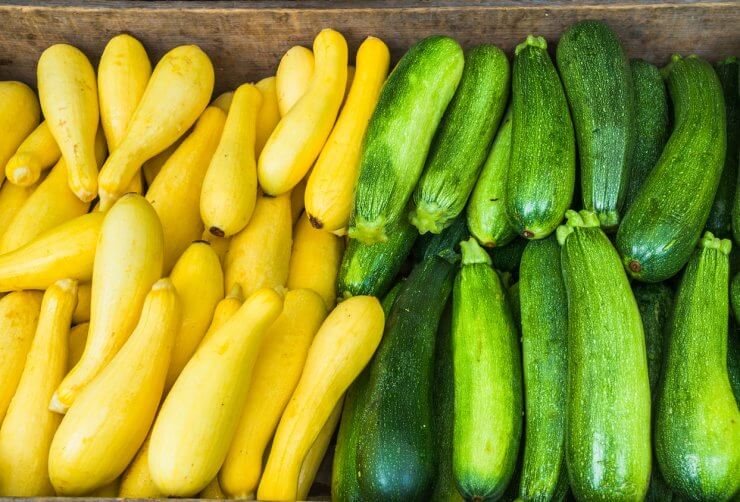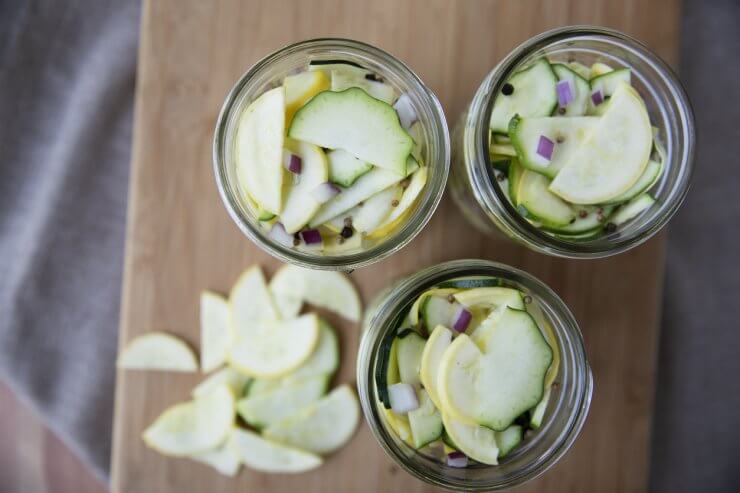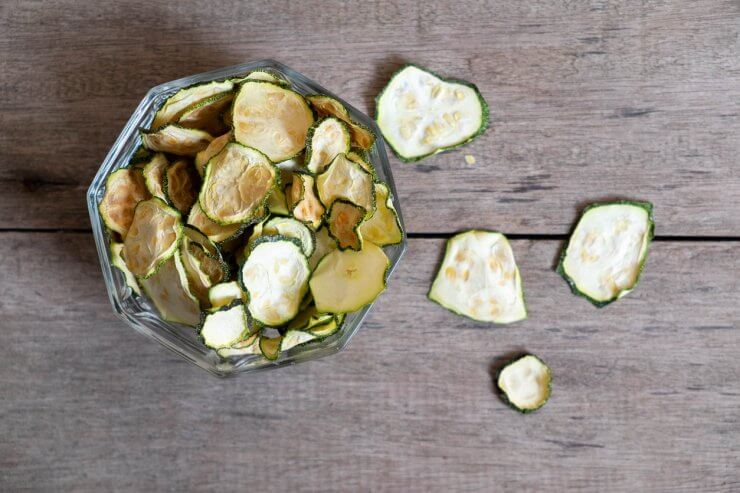
On my quest to learn how to preserve zucchini and summer squash, I had to pause for a moment and think about why it was so important to me. One of my goals over the past couple of years (this last one in particular) has been to become more self-sufficient. There’s something very empowering about not having to rely on the grocery store for fresh vegetables. Don’t get me wrong. I love the grocery store and all of its heavenly (see: chocolate) delights. But knowing I can save money and feed my family homegrown veggies throughout the summer makes my inner child (heavily influenced by Little House on the Prairie and Oregon Trail) sing.
Zucchini and summer squash has always been a staple in my vegetable garden. I love cooking and even baking with zucchini and summer squash. But my heart sinks a little bit at the end of summer when I know that I have to return to store-bought zucchini and yellow squash instead of my homegrown favorites. I knew I wanted to learn how to preserve zucchini and summer squash and looked to the experts and homesteaders for guidance.
Storing squash in a cool dry basement works really well for winter squash varieties like butternut or acorn. But summer squashes are more prone to rot because their moisture content is higher and they have thinner skin. In order to preserve zucchini and summer squash, it’s best to cut it up first. Here are five ways to preserve your homegrown zucchini and summer squash so you can enjoy it well into the fall and winter.

Freezer Method
In our journey to learn how to preserve zucchini, the first stop is the freezer. My favorite way to freeze zucchini and summer squash is to follow these simple instructions:
- Cut squash into half-inch slices and blanch them in salted boiling water for about a minute. Blanching stops enzyme activity which is the stuff that causes texture changes and a loss of nutrients.
- Drain them in a colander and dunk them in an ice bath to stop the cooking process.
- Drain them again and lay them in a single layer on a baking tray.
- Flash freeze them for 30 minutes then transfer them to a freezer-safe bag or container. (Flash freezing prevents them from clumping together.)
Frozen zucchini and summer squash will last about a year in your freezer, though the longer you wait the less flavor you’ll taste.

Canning Method
When thinking of how to preserve zucchini and summer squash, canning is another great method to consider. Because zucchini and summer squash are low-acid vegetables, pressure canning is the safe method to choose. Be sure to follow your pressure canner’s instructions, but the basic process is this:
- Scrub your zucchini clean
- Bring a large pot of water to a boil
- Cut ends off zucchini and cut the squash into your desired shape (slices, spears, even spiralized).
- Optional: blanch your squash pieces in boiling water for 30 seconds. This is optional if you’re looking to retain texture and shape.
- Place cut pieces into canning jars, being sure not to jam them in. You want to make sure hot water will circulate. Leave about an inch of headspace.
- Pour boiling water over the squash, maintaining the one-inch headspace. Tap jar gently to remove any air bubbles.
- Seal the lids and process them according to your pressure canner’s instructions.
Canned zucchini and summer squash are great for purees, baby food, and soups. But the texture doesn’t maintain as well as freezing and other methods. Canned zucchini and summer squash will keep for several months on the shelf, but keep an eye out for signs of mold or discoloration.

Pickling Method
Another way of preserving zucchinis is by pickling them. There are two pickling methods: the quick-pickling method and the standard pickling method. Quick pickles are easy upfront but only last about 2 weeks in the refrigerator. This is great if you’re just looking to extend the squash life for a little while.
To preserve zucchini pickles longer, I recommend the standard pickling process which involves covering sliced or speared zucchini with a vinegar-based pickling liquid and using a water bath canning method. Each pickling recipe is a little different, so I definitely recommend finding one that fits your flavor preferences. Because you’re using an acidic additive like vinegar, the water bath method is a safe way to pickle and preserve zucchini. Using this method will preserve your summer squash for about a year.

Fermentation Method
The difference between pickling and fermenting is that pickling introduces acidity and adds heat which kills harmful bacteria. Fermenting is a chemical reaction between a food’s natural sugar and natural bacteria without any added acid. The most common bacteria you’ll see in fermented foods is lactobacillus, which eats sugars and carbs and produces lactic acid. The lactic acid is what ends up preserving the fermented food. Fermented foods can aid in digestive health because of their probiotics and enzymes.
When learning how to preserve zucchini and summer squash, it hadn’t occurred to me that fermentation was an option. But when thinking about my love for other fermented foods like kimchi and sauerkraut, fermenting Zucchini doesn’t seem like that much of a stretch. I’m a big fan of using a fermentation kit like this, that comes with all the instruments you’ll need. Just like with pickling, it’s important to find a recipe that works best for you but the general fermentation process is this:
- Wash and cut your zucchini into slices or spears
- Fill the jar with zucchini and herbs and spices (and whatever else your recipe calls for)
- Make a brine based on your given recipe (this may include whey, non-chlorinated water, and other recipe-specific ingredients)
- Fill the jar with brine and weigh zucchini down using a pickling weight or small jar lid, so that it remains under the brine
- Seal according to your fermentation kit
Depending on your fermentation recipe and the ingredients used, your fermented zucchini will last about a month in the refrigerator.

Dehydration Method
When it comes to learning how to preserve zucchini and summer squash, you’ve got to try the dehydration method. And while a food dehydrator is certainly nice to have, you can accomplish the dehydration process using a standard oven just as easily.
The benefit of dehydrating zucchini is that you can enjoy them as zucchini chips or you can store them and rehydrate them in pasta dishes by tossing them into boiling water along with your pasta. This works with soups and stews as well. The dehydration process is pretty simple:
- Wash, trim and cut zucchini or summer squash. Quarter-inch slices work best, though you can also grate zucchini depending on how you plan on using it later.
- Arrange slices on dehydrator trays, trying not to overlap them. Follow your dehydrator’s instructions.
- If using an oven, arrange slices on a parchment paper-lined baking sheet. Set oven to lowest temperature (usually 150˚F), leaving the door slightly open. Let dry in the oven for 2-5 hours or until zucchini is brittle.
Once dried, you can season your dehydrated zucchini with salt, pepper, and other spices for a delicious snack. Or seal them plain in an air-tight container. If stored properly, dried zucchini and summer squash can be stored for up to a year.
Have you already learned how to preserve zucchini or summer squash? What is your favorite method? Let me know in the comments.


 Previous
Previous


For article on pollinator plants although Goldenrod does not produce pollen, lots of insects like to be on it. It is Allopathic and will kill plants near it just like sunflowers do. A wild flower mix can be spread around area of garden, and it attracts all kinds of insects including dragonflies. A shallow wide container with marbles and water not quite to top of marbles will be visited by honey bees. A nest for bluebirds attracts a bird that eats lots of insects. Lots of flower mix seeds marked as pollinator attractors is inexpensive too.
If you prefer fried squash and/or zucchini, I recommend slicing them and prepare them as though you are going to fry them. By that, I mean dip into you beaten egg/milk mixture, and then into your premixed flour and cornmeal (I season mine with Tony’s, salt and pepper). After you dip, you would want to have several cookie baking sheets pre lined with freezer paper, and lay them out side by side (DONT NOT STACK THE VEGGIES ON TOP OF THE OTHER) in a single layer and place them in the freezer for at least an hour. This allows them to easily be placed into you vacuum sealed bags without them sticking together.
Then freeze ????
When you are craving some fried squash, all you have to do is get a bag out of your freezer, and fry them from frozen (do not allow to dethaw, they will get mushy). ????
FYI, pressure canning summer squash is no longer recommended as there is no data to support the safety in doing so. Reference: So Easy to Preserve canning book
We also shred and freeze both yellow and zucchini. Great addition to pasta sauce and soups.
I’ve shredded mine and put them in the freezer too. Does it have to be blanched as well like the slices? I didn’t know and didn’t blanch mine.
Because the zucchini shreds are small, you should be fine without blanching first. Blanching helps the bigger pieces (slices) hold their texture and color.
My favorite way: Zucchini relish made with onions, peppers, vinegar, water, salt, sugar, turmeric, and celery seed. Bring to boil, put in sterilized jars and seal. So much better than store bought pickle relish!
Would you share where to find your favorite recipe? Would love to to try this!
I would love the recipe myself, my daughter loves zucchini and has for 45 years and I would love to surprise her with these. I think these sound amazing.
I usually shred zucchini, drain it in a salad spinner, then put in small ziplock bags (about 2-3 cups) and use that for zucchini bread, pie, cake, etc. during the winter. I never knew I could dehydrate them (in the oven) to use during the winter. Will have to try that.
I like to shred zucchini measure out2 cups an
D freeze. Use any cake mix and replace zucchini for liquid in cake mixes ( I like chocolate). Very moist so refrigerate extra.
I have been grinding up zucchini and draining it a bit and putting it in freezer bags to freeze for making fritters – like potato pancakes! Comes in handy during the winter when zucchini aren’t available!